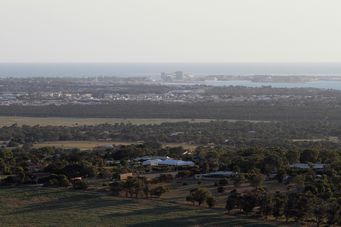
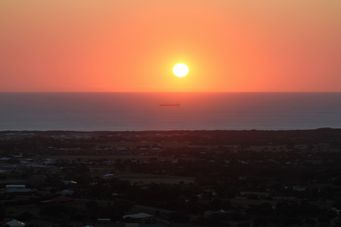
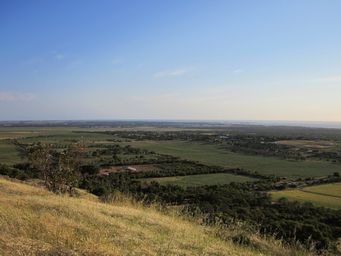
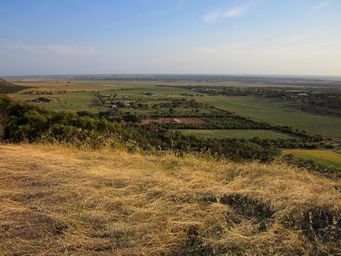
Lookout over Geraldton at sunset. This is on private farming property, and is a favourite of locals. We did not visit tourist sites in Geraldton this time.
On the 3rd of June 1851, the town site of Geraldton was declared and the first sale of Geraldton lots were sold by public auction in Perth. Geraldton was originally called Gerald's Town after Governor Charles Fitzgerald (1848-55) but later shortened to Geraldton.
History of Geraldton
In 1846 Augustus Gregory and his brothers Francis and Henry set out on their first big exploratory journey, searching principally for land suitable for agrciculture to the north of Perth. Gregory returned with glowing reports of good pastoral land and coal deposits in the mid-west coastal region.
Gregory's resource, bushcraft, facility for invention and technical expertise won him the confidence of his superiors and in 1846 he was given command of his first expedition. In seven weeks with his brothers Francis and Henry Churchman (1823-1869) he travelled north of Perth, and returned in December to report good grazing land and a promising coal seam on the Irwin River. Impressed by his enterprise a group of colonists invited him in 1848 to lead a settlers' expedition to map the Gascoigne River and seek more pastoral land. Although repelled by dense scrub the party charted part of the Murchison River and found traces of lead which led to the opening of the Champion Bay district centred on Geraldton.
Extract from Biography Sir Augustus Charles Gregory.
Read more about explorer Augustus Gregory's exploration and discoveries across Australia, and the legacy of places which now bear his name.
Mineral Deposits
The discovery of a coal seam in the Irwin River, lead and copper in the Murchinson River and pastoral opportunities in the hinterland created a boom in the area.
In December 1849 and the first shipment of five tons of ore was brought back to Champion Bay from Galena on the Murchison River.
In 1879, the Western Australian Government began the construction of the first government railway in the State, which carried lead ore from Northampton to the port. The port became a vital part of Geraldton's economy and became one of the State's major seaports.
In 1988 the town of Geraldton was officially declared a city.
Today the Port of Geraldton is a major west coast port with seven bulk handling berths and an average loading rate of seven tonnes per hour, ranking nationally (in tonnage for 2012/2013) 12th in exports (14,812,513); 23rd in imports (632,330); and 13th overall (15,444,843). The major exports from the Geraldton port in 2012/2013 were (tonnage): iron ore (10,741,662); grain (2,618,507); mineral sands (849,933); copper concentrate (149,450); zinc concentrate (148,420); nickel concentrate (65,919); and livestock (2,758). Major imports were petroleum products (328,021). In 2012/2013 the Geraldton port serviced 328 bulk haulage vessels.
By the early 1900's the fishing industry in Geraldton was established,
attracting Norwegians, Danes, Swedes and later Italians. During the 1950s, Western Rock Lobster (Crayfish) industry became a major
export for the state, with the United States of America being the main market. Now rock lobster is exported to Japan as well
as to USA.
Today the port city of Geraldton is a thriving city and port with a good range of shops and businesses. It is the centre of fishing, manufacturing, construction, agriculture and tourism industries of the Mid West region of the State.
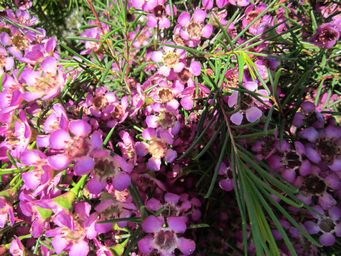
Australia So Much to See


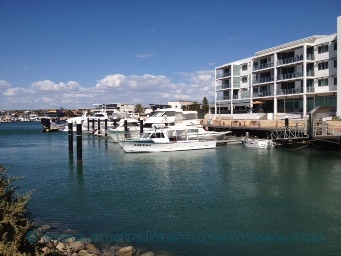
What is there to see in Geraldton?
HMAS Sydney II Memorial at Gummer Avenue, on Mount Scott, Geraldton and honours the 645 Australian sailors who were lost off the Western Australian coast during a World War II battle with German raider HSK Kormoran. The location of both wrecks remained a mystery for over 66 years until they were located in March 2008. See the solving of the mystery on the Finding Sydney Foundation.
The centrepiece is the Dome of Souls, constructed with 645 stainless steel seagulls representing the souls of the crew members lost.
. On completion on 1878, Point Moore Lighthouse was Australia’s fourth tallest lighthouse, its total height above the ground being 114 feet or 34 metres. The Point Moore lighthouse is the oldest surviving Commonwealth lighthouse in Western Australia, it is still in operation today and its beam can be seen 26 kilometres out to sea. The tall red and white banded structure is a Geraldton landmark.
Batavia Longboat Replica. On June
4 1629 a ships longboat sailed among the rocks and reefs of a small group of coral islands on the eastern fringes of the Indian Ocean.
She was launched into the surf from the deck of a Dutch East India ship, and she spent the day ferrying crew and passengers ashore.
It was the winter and the weather was stormy, but despite that by nightfall almost 180 people had been landed on a tiny island. The
islands were in the Abrolhos Archipelago, the ship was the Batavia, and she was wrecked. The replica Longboat sails most Sundays
from in front of the WA Museum Geraldton.
Western Australian Museum Geraldton. Overlooking the Indian Ocean, the Western
Australian Museum Geraldton celebrates the rich heritage of the land, sea and people of the Mid West region. Enjoy a guided tour through
the stories from four major early shipwrecks located in the region, the Batavia, Gilt Dragon, Zuytdorp, and Zeewijk or learn more
about the discovery of HMAS Sydney (II), the pride of the fleet.
The Birdwood Military Museum is situated in Birdwood
House, has an amazing display of memorabilia from the Boer War right through to more recent conflicts involving Australian forces. Situated at the corner of Chapman Road and Forrest Street, Geraldton.
Francis Xavier Cathedral. The cathedral's foundation stone
was laid in 1916 and the building was completed in 1938. Situated at the corner of Cathedral Avenue and Maitland Street, Geraldton.
Sparkling white beaches. With a mild to hot climate for much of the year, beaches are popular and there are a range to
suit families through the surfing beaches.
The city also has a large range of cafes and restaurants, services and
shopping centres.
Where to stay?
Caravan Parks
Drummond Cove Holiday Park ten kilometres north of the city
Low Cost Camping (no power or potable water)
Coronation Beach – 28 kilometres north of Geraldton along the North West Coastal Highway and eight kilometres of sealed access road. $7 per person per night (pensioners $6). Dogs on leads. Dump point provided. Pit toilets and shower cubicles for own showers, picnic area. Good windsurfing and fishing location right on the beach. Generators permitted in specified hours. Fills early in peak season. When this popular park is full, a notice will be placed on the highway at the turnoff.
Ellendale Pool – 45 kilometres south east of the city. (Pass through small settlement of Walkaway on way to pool) $5 per person per night honesty box with a three day limit. Dogs on leads. Dump point provided. Flushing toilets and outdoor cold shower, non potable water tap, barbecue, picnic area, playground, nice walking area and swimming spot.
Fig Tree Crossing – A rest area 15 kilometres north east of the city on Chapman Valley Road on the way to Nanson and Nabawa .$7 per person per night (pensioners $6) maximum stay 24 hours. Dogs on leads. Dump point provided. Pit toilet, covered picnic area, barbecue.
Geraldton - the city and port for the Mid West region of Western Australia